The firm that designed the new Bay Bridge eastern span warned Caltrans as the bridge neared completion that some of its welds could crack prematurely under the constant pounding of cars and trucks, The Chronicle has learned. In their November 2010 evaluation, the T.Y. Lin engineers identified a section of the eastbound deck near Yerba Buena Island as being of particular concern, because lopsided welded connections are under high stress and thus are especially vulnerable to premature cracking. Critics said Caltrans' actions undermined the span's status as a lifeline after an earthquake - a road intended to be open for emergency vehicles and trucks within a day - and could shorten its predicted 150-year life span. "What they've apparently done is rationalized the acceptance of excessive fatigue damage at these locations," said Bob Bea, a professor emeritus of civil engineering at UC Berkeley. When confronted with the problem, Caltrans' chief engineer, Brian Maroney, said builders could use laxer stress-level standards set by a national group, the American Association of State Highway and Transportation Officials, instead of the state guidelines. [...] Martin Pohll, a retired Caltrans structural steel expert who served on the agency panel that sets California's guidelines, said the state intentionally kept its standards higher than the national group's. Top officials from Caltrans, as well as its seismic peer review panel and bridge consultants, gathered for a briefing about the ill-fitting sections in October 2010. In a verbal presentation, T.Y. Lin's chief bridge designer, Marwan Nader, and consultants hired by the bridge's main contractor, the joint venture American Bridge/Fluor, said it was unlikely the welds would crack from traffic alone, according to minutes of the meeting. [...] the engineers said, welds on roughly half of the eastbound deck and a quarter of the westbound deck probably had excessive stress levels that didn't conform to Caltrans' standards. Hundreds of galvanized steel rods and bolts that hold together the signature tower, seismic-stability structures and other features of the span were manufactured to levels harder than Caltrans normally allows on bridges, a factor that may have left them more vulnerable to being invaded by corrosive marine air. -- Design flaws, corrosion, fabrication errors and snapped bolts dogged construction of the still-incomplete bike path, leading to at least $3.8 million in cost overruns.

|
Scooped by
PIRatE Lab
April 13, 2014 9:47 AM
|
No comment yet.
Sign up to comment



 Your new post is loading...
Your new post is loading...








While I don' think this is nearly as problematic as our joke-of-a-design levee system in New Orleans and elsewhere around our country, this "dumbing down" of safety standards on the fly is simply unacceptable. This is crazy. To put in this kind of time and money and faith, we expect our engineered structures to be able to withstand routine and predicted peak stresses well. The whole argument of "the U.S. knows better than we dumb Californians" simply doesn't fly. If we ordered a part that is to be to specific tolerances, then it should have been to specific tolerances.